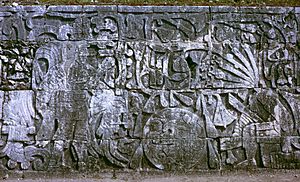Human sacrifice in Maya culture facts for kids
During the times before Christopher Columbus arrived in the Americas, human sacrifice in Maya culture was a special ritual. It was a way for the Maya people to offer important gifts to their gods. The Maya believed that blood was a very powerful source of energy for their gods. Because of this, offering a living creature was a strong way to give blood. Giving a human life was seen as the greatest offering of blood to the gods. Many important Maya ceremonies ended with human sacrifice. Usually, only important prisoners captured in battles were sacrificed. Less important captives were often used for work instead.

Human sacrifice among the Maya is known to have happened from at least the Classic period (around 250 to 900 AD). It continued right up to the final stages of the Spanish conquest in the 1600s. We know about human sacrifice from several sources:
- It is shown in Maya artwork from the Classic period.
- It is mentioned in hieroglyphic writings from the Classic period.
- Scientists have found proof by studying human bones from both the Classic and Postclassic periods (around 900 to 1524 AD).
- It is also described in many old Maya books and early Spanish writings. These include the Madrid Codex, the Kʼicheʼ story Popol Vuh, and writings by Diego de Landa like his Relación de las cosas de Yucatán.
Contents
Why the Maya Offered Human Life
The Maya believed that their gods needed special energy to keep the world going. They thought that blood was the most powerful way to give this energy. By offering human life, they were giving the ultimate gift to their gods. This was done to please the gods, ask for good harvests, or to ensure the sun would rise each day.
Who Was Chosen for Sacrifice?
Most often, the people chosen for sacrifice were important prisoners captured during wars. These prisoners were usually leaders or warriors from other cities. The Maya believed that offering these high-ranking captives would bring greater favor from the gods. Sometimes, children or other members of society might also be chosen, but this was less common than sacrificing war prisoners.
Evidence of Maya Sacrifice
We have learned about Maya human sacrifice from many different kinds of evidence.
Art and Writings
Many ancient Maya artworks, like carvings and paintings, show scenes of sacrifice. These images help us understand how the rituals were performed. Maya hieroglyphic texts, which are their ancient writings, also describe these events. These texts often name the people involved and the reasons for the sacrifices.
Archaeological Discoveries
Archaeologists have found human bones at Maya sites. By studying these bones, they can see signs of how the people died. For example, cut marks on bones can show that someone was sacrificed. These discoveries match what is seen in Maya art and writings.
Historical Records
After the Spanish arrived, they wrote down what they saw and learned about Maya culture. These records, along with older Maya books that survived, give us more details about human sacrifice. They help us understand the beliefs and practices of the Maya people.
See also
 In Spanish: Sacrificios humanos en la cultura maya para niños
In Spanish: Sacrificios humanos en la cultura maya para niños

